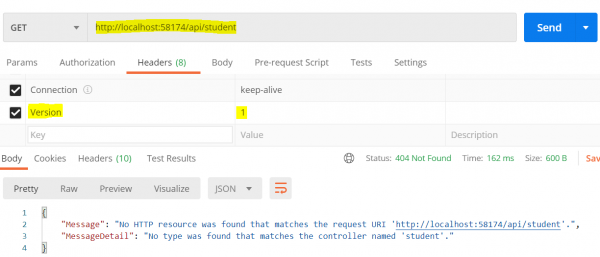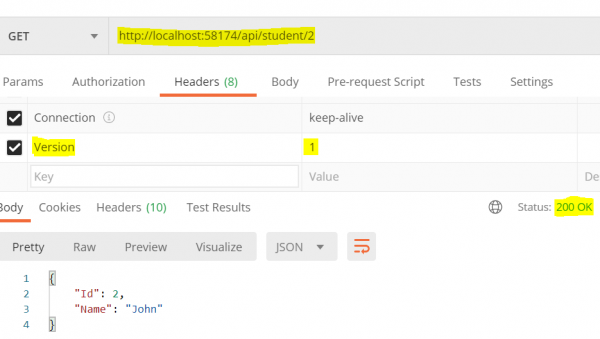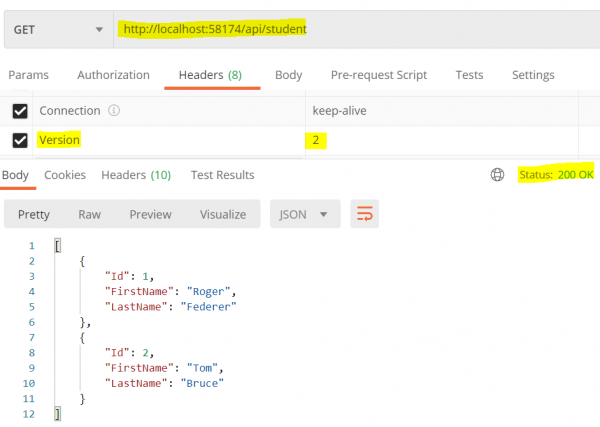
 Data Structure
Data Structure Networking
Networking RDBMS
RDBMS Operating System
Operating System Java
Java MS Excel
MS Excel iOS
iOS HTML
HTML CSS
CSS Android
Android Python
Python C Programming
C Programming C++
C++ C#
C# MongoDB
MongoDB MySQL
MySQL Javascript
Javascript PHP
PHPPhysics
Chemistry
Biology
Mathematics
English
Economics
Psychology
Social Studies
Fashion Studies
Legal Studies
- Selected Reading
- UPSC IAS Exams Notes
- Developer's Best Practices
- Questions and Answers
- Effective Resume Writing
- HR Interview Questions
- Computer Glossary
- Who is Who
How to do versioning with accept header in C# ASP.NET WebAPI?
The Accept header tells the server in what file format the browser wants the data. These file formats are more commonly called as MIME-types. MIME stands for Multipurpose Internet Mail Extensions.
Versioning can be send in Headers like below.
Version=1 StudentsV1Controller Version=2 StudentsV2Controller

Since we have not handled the version in accept headers, we are getting 404 not found error as we only have StudentV1 and StudentV2 controller. Let us add our own CustomControllerSelector which implements the DefaultHttpControllerSelector class.
CustomControllerSelector −
Example
using System.Linq;
using System.Net.Http;
using System.Web.Http;
using System.Web.Http.Controllers;
using System.Web.Http.Dispatcher;
namespace WebAPI.Custom{
public class CustomControllerSelector : DefaultHttpControllerSelector{
private HttpConfiguration _config;
public CustomControllerSelector(HttpConfiguration config) : base(config){
_config = config;
}
public override HttpControllerDescriptor SelectController(HttpRequestMessage
request){
var controllers = GetControllerMapping();
var routeData = request.GetRouteData();
var controllerName = routeData.Values["controller"].ToString();
string versionNumber = "";
var acceptHeader = request.Headers.Accept.Where(a => a.Parameters
.Count(p => p.Name.ToLower() == "version") > 0);
if (acceptHeader.Any()){
versionNumber = acceptHeader.First().Parameters
.First(p => p.Name.ToLower() == "version").Value;
}
HttpControllerDescriptor controllerDescriptor;
if (versionNumber == "1"){
controllerName = string.Concat(controllerName, "V1");
}
else if (versionNumber == "2"){
controllerName = string.Concat(controllerName, "V2");
}
if (controllers.TryGetValue(controllerName, out controllerDescriptor)){
return controllerDescriptor;
}
return null;
}
}
}The next thing that we need to replace the default controller selector with our custom controller selector. This is done in WebApiConfig.cs file. Notice we are replacing IHttpControllerSelector, with our CustomControllerSelector. DefaultHttpControllerSelector implements IHttpControllerSelector, so that is the reason we are replacing IHttpControllerSelector.
Example
public static class WebApiConfig{
public static void Register(HttpConfiguration config){
config.Services.Replace(typeof(IHttpControllerSelector), new
CustomControllerSelector(config));
config.MapHttpAttributeRoutes();
config.Routes.MapHttpRoute(
name: "DefaultApi",
routeTemplate: "api/{controller}/{id}",
defaults: new { id = RouteParameter.Optional }
);
}
}StudentV1Controller −
Example
using DemoWebApplication.Models;
using System.Collections.Generic;
using System.Linq;
using System.Web.Http;
namespace DemoWebApplication.Controllers{
public class StudentV1Controller : ApiController{
List<StudentV1> students = new List<StudentV1>{
new StudentV1{
Id = 1,
Name = "Mark"
},
new StudentV1{
Id = 2,
Name = "John"
}
};
public IEnumerable<StudentV1> Get(){
return students;
}
public StudentV1 Get(int id){
var studentForId = students.FirstOrDefault(x => x.Id == id);
return studentForId;
}
}
}StudentV2Controller −
Example
using DemoWebApplication.Models;
using System.Collections.Generic;
using System.Linq;
using System.Web.Http;
namespace DemoWebApplication.Controllers{
public class StudentV2Controller : ApiController{
List<StudentV2> students = new List<StudentV2>{
new StudentV2{
Id = 1,
FirstName = "Roger",
LastName = "Federer"
},
new StudentV2{
Id = 2,
FirstName = "Tom",
LastName = "Bruce"
}
};
public IEnumerable<StudentV2> Get(){
return students;
}
public StudentV2 Get(int id){
var studentForId = students.FirstOrDefault(x => x.Id == id);
return studentForId;
}
}
}Below outputs shows the results that we get from StudentV1 and StudentV2 controllers with versioning in accept headers.



